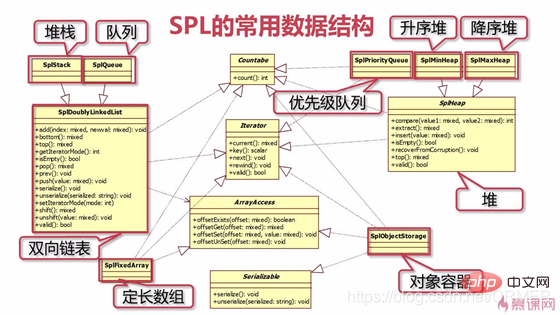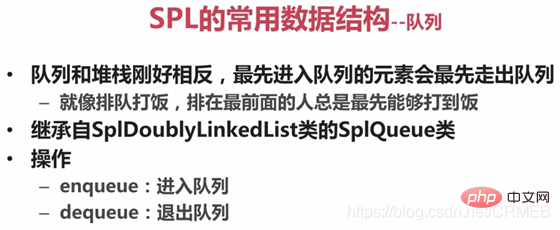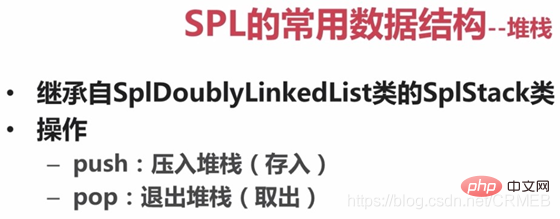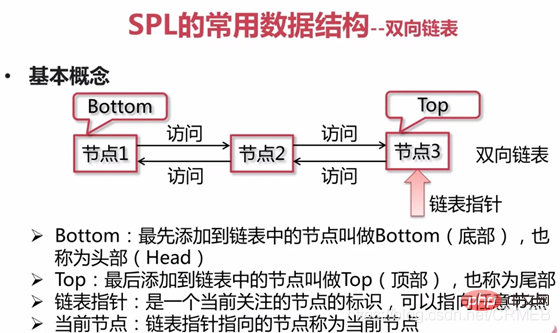Parsing the PHP standard library SPL data structure

SPL provides doubly linked lists, stacks, queues, heaps, descending heaps, ascending heaps, priority queues, fixed-length arrays, and object containers

SplQueue queue class
In and out, first in, first out

<?php$obj = new SplQueue();//插入一个节点到top位置$obj->enqueue(1);
$obj->enqueue(2);
$obj->enqueue(3);/**
SplQueue Object
(
[flags:SplDoublyLinkedList:private] => 4
[dllist:SplDoublyLinkedList:private] => Array
(
[0] => 1
[1] => 2
[2] => 3
)
)
*/$obj->offsetSet(0,'C');/**
SplQueue Object
(
[flags:SplDoublyLinkedList:private] => 4
[dllist:SplDoublyLinkedList:private] => Array
(
[0] => 'C'
[1] => 2
[2] => 3
)
)
*/$obj->rewind();//从队列中返回并删除bottom位置的元素$obj->dequeue();/**
'C'
SplQueue Object
(
[flags:SplDoublyLinkedList:private] => 4
[dllist:SplDoublyLinkedList:private] => Array
(
[0] => 2
[1] => 3
)
)
*/复制代码SplStack stack class
When entering and exiting single-ended, Last in, first out, first in, last out

$obj = new SplStack();/**
SplStack Object
(
[flags:SplDoublyLinkedList:private] => 6
[dllist:SplDoublyLinkedList:private] => Array
(
)
)
*///向堆栈放入一个节点到top位置$obj->push(1);
$obj->push(2);
$obj->push(3);/**
SplStack Object
(
[flags:SplDoublyLinkedList:private] => 6
[dllist:SplDoublyLinkedList:private] => Array
(
[0] => 1
[1] => 2
[2] => 3
)
)
*///堆栈的offset = 0 是Top所在的位置,offset = 1 是top节点靠近bottom位置的相邻节点$obj->offsetSet(0,'C');/**
SplStack Object
(
[flags:SplDoublyLinkedList:private] => 6
[dllist:SplDoublyLinkedList:private] => Array
(
[0] => 1
[1] => 2
[2] => 'C'
)
)
*/$obj->offsetSet(1,'B');/**
SplStack Object
(
[flags:SplDoublyLinkedList:private] => 6
[dllist:SplDoublyLinkedList:private] => Array
(
[0] => 1
[1] => 'B'
[2] => 'C'
)
)
*///堆栈的rewind使指针指向top节点,而双向链表的rewind指向bottom节点$obj->rewind();//堆栈的next是使指针向bottom方向相邻的节点移动一位,而链表是向top方向移动$obj->next();//遍历堆栈$obj->rewind();while($obj->valid()){ echo $obj->key().'=>'.$obj->current();
$obj->next();
}/**
2=>'C'
1=>'B'
0=>1
*///从堆栈中取出top位置的节点并删除$obj->pop();复制代码SplDoublyLinkedList Doubly linked list class

$obj = new SplDoublyLinkedList();//SplDoublyLinkedList Object ( [flags:SplDoublyLinkedList:private] => 0 [dllist:SplDoublyLinkedList:private] => Array ( ) )//把新的节点数据添加到链表的顶部Top$obj->push(1);
$obj->push(2);
$obj->push(3);//把新的节点数据添加到链表底部bottom$obj->unshift(4);/**
SplDoublyLinkedList Object
(
[flags:SplDoublyLinkedList:private] => 0
[dllist:SplDoublyLinkedList:private] => Array
(
[0] => 4
[1] => 1
[2] => 2
[3] => 3
)
)
*///在没有调用rewind()方法之前输出为nullecho 'current'.$obj->current();//输出: null//把指针指向bottom节点$obj->rewind();//获取当前指针指向的节点$obj->current();//输出: 4//将执行挪到下一个$obj->next();
$obj->current();//输出: 1$obj->prev();
$obj->current();//输出: 4//越界了$obj->next();
$obj->next();
$obj->next();
$obj->next();
$obj->current();//输出: null//判断当前节点是否有效$obj->valid()//输出: false$obj->prev();
$obj->valid()//输出: true$obj->shift();//把top节点从链表中删除并返回$obj->pop();//输出 3//把bottom节点从链表中删除并返回$obj->shift();//输出 4//返回top节点$obj->top();//返回bottom节点$obj->bottom();复制代码Thanks If your reading is helpful to you, please follow "CRMEB". There are our open source mall projects and knowledge payment projects on Code Cloud, which are all developed based on PHP vue. You are welcome to use them for learning and research. Follow us to stay in touch!
If you want to learn more about programming, please pay attention to the php training column!
The above is the detailed content of Parsing the PHP standard library SPL data structure. For more information, please follow other related articles on the PHP Chinese website!

Hot AI Tools

Undresser.AI Undress
AI-powered app for creating realistic nude photos

AI Clothes Remover
Online AI tool for removing clothes from photos.

Undress AI Tool
Undress images for free

Clothoff.io
AI clothes remover

Video Face Swap
Swap faces in any video effortlessly with our completely free AI face swap tool!

Hot Article

Hot Tools

Notepad++7.3.1
Easy-to-use and free code editor

SublimeText3 Chinese version
Chinese version, very easy to use

Zend Studio 13.0.1
Powerful PHP integrated development environment

Dreamweaver CS6
Visual web development tools

SublimeText3 Mac version
God-level code editing software (SublimeText3)

Hot Topics
 1654
1654
 14
14
 1413
1413
 52
52
 1306
1306
 25
25
 1252
1252
 29
29
 1225
1225
 24
24
 Explain JSON Web Tokens (JWT) and their use case in PHP APIs.
Apr 05, 2025 am 12:04 AM
Explain JSON Web Tokens (JWT) and their use case in PHP APIs.
Apr 05, 2025 am 12:04 AM
JWT is an open standard based on JSON, used to securely transmit information between parties, mainly for identity authentication and information exchange. 1. JWT consists of three parts: Header, Payload and Signature. 2. The working principle of JWT includes three steps: generating JWT, verifying JWT and parsing Payload. 3. When using JWT for authentication in PHP, JWT can be generated and verified, and user role and permission information can be included in advanced usage. 4. Common errors include signature verification failure, token expiration, and payload oversized. Debugging skills include using debugging tools and logging. 5. Performance optimization and best practices include using appropriate signature algorithms, setting validity periods reasonably,
 How does session hijacking work and how can you mitigate it in PHP?
Apr 06, 2025 am 12:02 AM
How does session hijacking work and how can you mitigate it in PHP?
Apr 06, 2025 am 12:02 AM
Session hijacking can be achieved through the following steps: 1. Obtain the session ID, 2. Use the session ID, 3. Keep the session active. The methods to prevent session hijacking in PHP include: 1. Use the session_regenerate_id() function to regenerate the session ID, 2. Store session data through the database, 3. Ensure that all session data is transmitted through HTTPS.
 What is REST API design principles?
Apr 04, 2025 am 12:01 AM
What is REST API design principles?
Apr 04, 2025 am 12:01 AM
RESTAPI design principles include resource definition, URI design, HTTP method usage, status code usage, version control, and HATEOAS. 1. Resources should be represented by nouns and maintained at a hierarchy. 2. HTTP methods should conform to their semantics, such as GET is used to obtain resources. 3. The status code should be used correctly, such as 404 means that the resource does not exist. 4. Version control can be implemented through URI or header. 5. HATEOAS boots client operations through links in response.
 How do you handle exceptions effectively in PHP (try, catch, finally, throw)?
Apr 05, 2025 am 12:03 AM
How do you handle exceptions effectively in PHP (try, catch, finally, throw)?
Apr 05, 2025 am 12:03 AM
In PHP, exception handling is achieved through the try, catch, finally, and throw keywords. 1) The try block surrounds the code that may throw exceptions; 2) The catch block handles exceptions; 3) Finally block ensures that the code is always executed; 4) throw is used to manually throw exceptions. These mechanisms help improve the robustness and maintainability of your code.
 What are anonymous classes in PHP and when might you use them?
Apr 04, 2025 am 12:02 AM
What are anonymous classes in PHP and when might you use them?
Apr 04, 2025 am 12:02 AM
The main function of anonymous classes in PHP is to create one-time objects. 1. Anonymous classes allow classes without names to be directly defined in the code, which is suitable for temporary requirements. 2. They can inherit classes or implement interfaces to increase flexibility. 3. Pay attention to performance and code readability when using it, and avoid repeatedly defining the same anonymous classes.
 What is the difference between include, require, include_once, require_once?
Apr 05, 2025 am 12:07 AM
What is the difference between include, require, include_once, require_once?
Apr 05, 2025 am 12:07 AM
In PHP, the difference between include, require, include_once, require_once is: 1) include generates a warning and continues to execute, 2) require generates a fatal error and stops execution, 3) include_once and require_once prevent repeated inclusions. The choice of these functions depends on the importance of the file and whether it is necessary to prevent duplicate inclusion. Rational use can improve the readability and maintainability of the code.
 Explain different error types in PHP (Notice, Warning, Fatal Error, Parse Error).
Apr 08, 2025 am 12:03 AM
Explain different error types in PHP (Notice, Warning, Fatal Error, Parse Error).
Apr 08, 2025 am 12:03 AM
There are four main error types in PHP: 1.Notice: the slightest, will not interrupt the program, such as accessing undefined variables; 2. Warning: serious than Notice, will not terminate the program, such as containing no files; 3. FatalError: the most serious, will terminate the program, such as calling no function; 4. ParseError: syntax error, will prevent the program from being executed, such as forgetting to add the end tag.
 PHP and Python: Comparing Two Popular Programming Languages
Apr 14, 2025 am 12:13 AM
PHP and Python: Comparing Two Popular Programming Languages
Apr 14, 2025 am 12:13 AM
PHP and Python each have their own advantages, and choose according to project requirements. 1.PHP is suitable for web development, especially for rapid development and maintenance of websites. 2. Python is suitable for data science, machine learning and artificial intelligence, with concise syntax and suitable for beginners.




